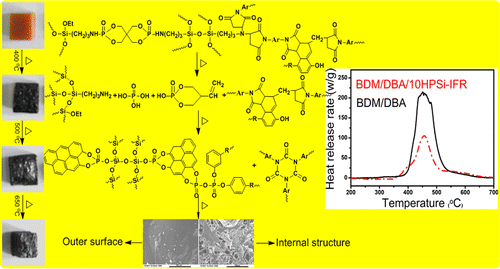Flame Retardancy and Mechanism of Bismaleimide Resins Based on a Unique Inorganic–Organic Hybridized Intumescent Flame Retardant
Chengwu Yang , Guozheng Liang * (梁国正), Aijuan Gu * (顾嫒娟), and Li Yuan
Ind.
To completely overcome three critical disadvantages of traditional intumescent flame retardants, a unique hybridized intumescent flame retardant (HPSi-IFR) with three-dimensional structure was synthesized, which has amine groups and Si and P elements. HPSi-IFR has very high thermal stability under either a nitrogen or air atmosphere. With a small addition of HPSi-IFR, the modified bismaleimide/diallyl bisphenol A (BDM/DBA) resin has significantly improved flame retardancy. With only 5 wt % addition of HPSi-IFR into BDM/DBA resin, the residue at 800 °C increases 23.1 wt %; meanwhile, the heat release capacity, the total heat release, and the maximum heat release are only 67, 55, and 63% of those of BDM/DBA resin, respectively. To reveal the mechanism behind the attractive flame retarding effect of HPSi-IFR, the char formation chemistry and thermodegradation kinetics were intensively studied. Results show that HPSi-IFR greatly improves the ability of producing a stable and condensed barrier that prevents the heat and mass transfer.

链接: //pubs.acs.org/doi/abs/10.1021/ie402047v